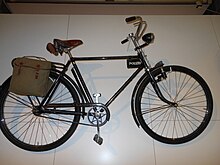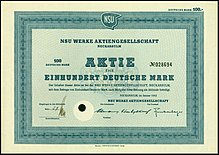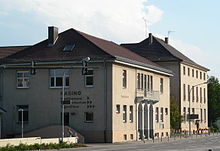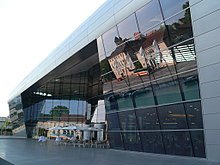NSU engine works
NSU was a German manufacturer of bicycles , motorcycles , automobiles and scooters , founded in Riedlingen in 1873 by Christian Schmidt and Heinrich Stoll and relocated to Neckarsulm in 1880 . In 1969 there was a company merger to Audi NSU Auto Union AG and in 1985 the name was changed to Audi , whereby the name NSU disappeared in 1985.
The company originally operated as a “mechanical workshop for the production of knitting machines”, but produced bicycles from 1886 and from 1901 was significantly involved in the early development of motorcycles in Germany. In the mid-1950s, NSU was the largest two-wheeler manufacturer in the world in terms of numbers.
The name NSU , which was used as a brand name or trademark from 1892, is an abbreviation for the city name Neckarsulm , which in turn is derived from the two rivers Neckar and Sulm , which flow together here. For the company logo, one of the three lying stag poles was initially borrowed from the Württemberg state coat of arms of 1806 and the letters N, S, U were entered between its four prongs . Contrary to a widespread misconception, the name NSU is not derived from “Sewing and Knitting Machine Union” or “Neckarsulmer Strickwaren Union”. There never was a company that would have had one of these names .
Company history
The years 1873 to 1918

The company was founded in 1873 by Christian Schmidt and Heinrich Stoll in Riedlingen an der Donau . Originally they manufactured knitting machines, hence the name "Mechanical workshop for the manufacture of knitting machines". In 1880 the company moved its headquarters to Neckarsulm near Heilbronn to a former sawmill and plaster mill (Brunnersche Mühle) on the Sulm . The reason was the higher space and energy requirements. Christian Schmidt died in February 1884 at the age of 39. On April 27, 1884, the company was converted into a stock corporation and was called Neckarsulmer Strickmaschinen-Fabrik AG from then on .
The manufacture of bicycles began in 1886. Germania was the first high-powered bicycle from NSU, followed later by low-level bicycles such as the 1888 safety two-wheeler "Pfeil". From 1892 onwards, no more knitting machines were manufactured.
In 1897 the company was called "Neckarsulmer Fahrradwerke AG". From 1901 motorcycles were also produced. The engine with 211 cm³, a single-cylinder four-stroke engine, came from Zedel . The first "Neckarsulm motorcycle" (so the label on the tank) with an output of approx. 1.25 hp reached a top speed of almost 40 km / h. From 1904/05 the motorcycles were partly called “N. S. U. "
In 1906, after the three-wheeled “Sulmobil”, the development of automobiles with the name “Neckarsulmer Motorwagen” began. From 1913 the company traded as "Neckarsulmer Fahrzeugwerke AG" and "NSU" (without dots) became an official trademark. In 1913 the company employed around 1200 workers and produced around 13,000 bicycles and 2,500 motorcycles. Before the First World War, NSU was the largest exporter of German motorcycle manufacturers and exported mainly to Russia, many European countries, Scandinavia, Turkey and Brazil. When the First World War broke out in 1914, a 3.5 hp war motorcycle and trucks with a payload of 1.25 and 2.5 tons were manufactured for the army.
The years 1919 to 1945
Due to the positive development in demand for automobiles, NSU decided to set up another car plant, which was built in the neighboring city of Heilbronn in 1925 . In 1926, the company merged with the bankrupt Berlin coachwork company Carosseriewerke Schebera AG to form NSU Vereinigte Fahrzeugwerke AG Neckarsulm . The takeover caused NSU economic problems, and after the Berlin ventures the Heilbronn plant had to be sold, which was taken over by Fiat in 1928 and incorporated into the newly founded NSU-Automobil AG Heilbronn (which existed alongside the NSU in Neckarsulm, see NSU-Fiat ). In 1932, NSU had to give up car production and parted ways with Fiat, which continued to operate the Heilbronn plant on its own.
NSU achieved a high level of awareness with the model 501 T motorcycles produced from 1927 to 1929 and the luxury variant, the 501 L. The reliability of the 501 models led to the name "Neckarsulm Tractor". To promote motorcycle sales, NSU formed a manufacturing and sales community with Deutsche Industriewerke AG from Berlin (D-Rad) in July 1932 until 1938 under the name NSU D-Rad Vereinigte Fahrzeugwerke AG Neckarsulm , recognizable by the large D in the lower part of the logo .
After Otto Reitz, NSU's chief designer, was replaced in 1930 by the former Norton Motors Ltd. (England), Walter William Moore , was replaced, the designs and the model versions changed radically. After the success of the super sport models 500 SS and 600 SS, the series models 201, 251, 351, 501, 601 OSL and 351 OT soon came onto the market. Similarities with models from Norton arose from the fact that Moore brought experience and designs from the English motorcycle industry. For example, on the OSL models with foot control, the gearshift lever is on the right-hand side. The Kickstarter can also be found on this page. The weak points are also similar to the English models from Norton: occasional oil leaks and vulnerable carburettors (AMAL carburettors).
By and large, with the aforementioned models, the company reached its peak before World War II . In 1938, 3,500 employees produced around 136,000 bicycles and 63,000 motorcycles. One of the successful models was the “ NSU-D Quick ” motorbike , of which around 240,000 were built between 1936 and 1953. This 98 cm³ motor bike, which was available as a men's and women's bike, had around 3 hp, drove a maximum of 55 to 60 km / h and consumed almost two liters of fuel per 100 km. Before the war it cost 290 Reichsmarks, in 1953 the price was 625.00 DM.
The second man in design after Moore was Albert Roder from 1936 to 1938 , but in 1938 he went to Victoria in Nuremberg to become chief designer. Moore returned to England before the outbreak of war in 1939.
During the Second World War, the well-known Kettenkrad type HK 101, a half-track vehicle with a motorcycle fork , was built at the Neckarsulm plant . It was produced for the Wehrmacht during the war and for agriculture and forestry after the war. The engine came from the Opel Olympia car , as NSU did not have a sufficiently powerful unit in its range.
The years 1946 to 1968
The NSU-Werke emerged from the Second World War not only partially destroyed, but also financially extremely poor. The administration was initially carried out by trustees. One of them, Eduard Hilger, even spoke out in favor of closing or converting it into a cooperative when there was little cash available in 1946 and the plant continued to make losses. From July 1, 1946, Walter Egon Niegtsch was general director responsible for the fortunes of NSU, after having been provisional director with the approval of the military government and the office for property control. Niegtsch managed to give the company another perspective within a short period of time. He recognized that sporting successes were excellent advertising for the company's products, and he made sure that NSU got involved in racing again. The small series of the Sport Fox with a 98 cm³ engine was created on his initiative. Niegtsch's work at NSU was short-lived, however; he died on May 29, 1951 after a brief serious illness.
In 1946 Albert Roder came back to NSU and took over the vacant position of chief designer.
From 1947 motorcycle production began again with the pre-war models NSU Quick , NSU 125 ZDB and NSU 251 OSL . In 1949 the first new design was the NSU Fox 101 OSB, initially with a four-stroke and from 1951 with a two-stroke engine.
Between 1951 and 1954, small Italian motorcycle manufacturers bought the then modern NSU Fox engines and used them to build their motorcycles in small series.
Under the direction of the general director and chairman of the board Gerd Stieler von Heydekampf , NSU was the largest two-wheeler manufacturer in the world in the mid-1950s, with a production of just under 350,000 two-wheelers (1955) (see table overview ). The vehicles built by around 6,600 employees were exported to 90 countries.
The most successful were the NSU Lambretta motor scooter (a licensed construction of the Italian Lambretta motor scooter), of which 117,045 units were manufactured in six years, and the NSU Max 251 OSB, a 250 cm³ machine with an overhead camshaft and the ULTRAMAX push rod control , one Valve train by two push rods. For the "little man" there was the NSU Quick (98 cm³, with pedals), NSU 125 ZDB (123 cm³, with footrests) and the NSU Quickly moped . Other models were the Lux (200 cm³, two-stroke) and the Konsu l with 350 or 500 cm³ displacement (351 OS-T and 501 OS-T).
NSU motorcycles were at home on many race tracks and drove numerous titles and world records in the 1950s and in some cases also in the 1960s. The duels between Heiner Fleischmann (NSU) and Georg “Schorsch” Meier (BMW) wrote motorcycle racing history in the post-war period, as did Wilhelm Herz , Werner Haas , Rupert Hollaus, who died in an accident in 1954, and the sidecar team Hermann Böhm / Karl Fuchs. The use of the Thouret women's trio with Ilse Thouret and her daughters Elga and Anneliese with NSU Lambrettas in national rallies also had a strong advertising effect in 1950 .
The winning motorcycles pictured above can be viewed today in the German Two-Wheeler and NSU Museum . Werner Haas won the German and World Championships in the same year at the NSU Rennmax 1953 . In 1955, Hermann Paul Müller won the world championship title at the NSU Sportmax and Hans Baltisberger the title of German road champion . In 1953 Werner Haas won the German and the world championship in the 125 cc class on the "NSU Rennfox R11". Furthermore, in 1954 at the NSU Rennfox "Blue Whale" Werner Haas won the German and Rupert Hollaus the world championship.
Some selected speed and consumption world records:

- 1951: Wilhelm Herz (2 cyl., 500 cm³, compressor) streamlined fairing, 290 km / h
- 1954: BAUMM I (49 cm³, 3.4 PS = ~ 2.5 kW), streamlined fairing , 127 km / h, 1955 even 151 km / h
- 1954: BAUMM II (98 cm³, 7.2 HP = ~ 5.25 kW), streamlined fairing , 178 km / h
- 1955: BAUMM II (125 cm³, 18 HP = ~ 13 kW), streamlined fairing , 218 km / h
- 1956: BAUMM III consumption record 1.13 l / 100 km at an average speed of 100 km / h.
Motorcycle production ended with the ebb of the motorcycle wave in 1963, and bicycle manufacture in the mid-1960s. NSU motorcycles were produced in Yugoslavia by Preduzeće Tito Sarajevo for a few years and sold as NSU Pretis.

In 1953, NSU Werke AG developed their first post-war car, the NSU Prinz , initially as a three-wheeled cabin scooter with the engine of the Max motorcycle, then as a four-wheeled car with a 583 cm³ two-cylinder rear engine and 20 hp (also derived from the Max engine) (15 kW). In 1957 the car was presented at the IAA . It was followed in 1961 by the Prinz 4 in the typical "bathtub design", which offered good space economy. In 1959, the Sport-Prinz came on the market with the technology of the Prinz II or III (30 hp engine). The NSU Sport-Prinz was a sporty coupe with two seats; the so-called emergency seat in the stern was just a thinly padded board. The hatchback body was designed by Bertone .
Based on the Sport-Prinz, the NSU Wankel-Spider, presented in 1963, was the world's first automobile with a rotary piston engine. Outwardly, the Spider differed from the Sport-Prinz by a convertible top and the air inlets on the front for the water cooler installed in the front.
The racing did not let even the car area into account. The Prinz 4 was already able to keep up in rallies, and there were greater successes with the Prinz 1000, the 1200 TT and the 1000 TTS , with an air-cooled OHC four-cylinder in the rear , this time with a chain drive for the camshaft . These vehicles were designed as sports sedans, which anticipated the later concept of the VW Golf GTI with a favorable power-to-weight ratio . The 1000 TTS got 70 HP (51 kW, VW Beetle 34 HP = ~ 25 kW) as standard from a displacement of 998 cm³, and tuned to over 85 HP (62 kW). At that time, this corresponded to the engine power of vehicles in the upper middle class and luxury class, but the vehicle weighed less than 700 kg. Because of their agility, the TTS were particularly successful in slalom competitions long after production had ceased.
The NSU-TT engine was also used to power the world's most powerful series motorcycle at the time, the Münch TTS (Mammut).
The NSU Wankel-Spider (1964), the first motor vehicle with a Wankel engine , and the NSU Ro 80 (1967), an upper middle class sedan with a Wankel engine, trend-setting wedge-shape design by Claus Luthe and a very favorable drag coefficient of at the time , also became famous 0.35.
Overview and selected key data
Swell:
1969 - Audi and NSU
On August 21, 1969, what was then NSU AG and Auto Union GmbH, which was part of the Volkswagen Group and based in Ingolstadt, merged to form Audi NSU Auto Union AG , based in Neckarsulm. The K 70, which had just been developed at the time, was taken over by Volkswagen and built as the VW K 70 .
After the decision to close the Neckarsulm plant in 1975, a protest rally by IG Metall at a factory gate developed into a protest march to Heilbronn on April 18, 1975 , in which 7,000 of the 10,500 employees took part. This prevented the closure. 4,500 jobs were nevertheless cut.
In 1985 the name was changed to Audi AG , the name NSU disappeared from the company . The stock exchange symbol for the Audi AG share continues to be NSU, as today's Audi AG is legally nothing other than NSU AG, which has been renamed several times. The seat was relocated to Ingolstadt in Bavaria.
In October 2005 one of the last old buildings of the NSU Motorenwerke - the "NSU casino" - was demolished because it had to make way for an SE center. In the picture from July 2005, it is still reflected - almost symbolically - in the top right of the facade of the Audi Forum , which is exactly opposite at Christian-Schmidt-Platz.
NSU today
Today's NSU GmbH - the traditional company of Audi AG - is an Audi subsidiary and was founded in 1985 to maintain the tradition of the Neckarsulm location .
On September 30th and October 1st, 2006, the Audi plant in Neckarsulm celebrated the 100th anniversary of automobile manufacturing in Neckarsulm with an open day . With this anniversary celebration, production of the new Audi R8 sports car (resulting from the Le Mans study) began.
Two-wheel models at a glance
The most important NSU motorcycles 1901–1918
Swell:
The most important NSU motorcycles 1919–1945
Swell:
| Type | engine | Cubic capacity in cm³ | Max. Power in kW (PS) | at speed in 1 / min | construction time | image |
|---|---|---|---|---|---|---|
| NSU 4 hp | 2-cylinder four-stroke | 498 | 4.8 (6.5) | - | 1919-1922 | - |
| NSU 8 hp | 2-cylinder four-stroke | 996 | 8.9 (12) | - | 1921-1927 | - |
| NSU 502 T / TS | 2-cylinder four-stroke | 498 | 7.4 (10) | - | 1924-1926 | - |
| NSU 251 R | 1-cylinder four-stroke | 249 | 4.4 (6) | - | 1924-1928 |

|
| NSU 251 S | 1-cylinder four-stroke | 247 | 7.4 (10) | 4400 | 1927-1929 |

|
| NSU 251 T / TS | 1-cylinder four-stroke | 249 | 4.4 (6) | - | 1928-1933 | - |
| NSU 501 S. | 1-cylinder four-stroke | 494 | 12 (16) | 4400 | 1928-1930 | - |
| NSU 201 R / T | 1-cylinder four-stroke | 199 | 3.4 (4.5) | - | 1928-1930 | - |
| NSU 301 T | 1-cylinder four-stroke | 298 | 5.1 (7) | - | 1929-1930 |

|
| NSU 351 TS | 1-cylinder four-stroke | 346 | 5.9 (8) | - | 1930-1932 | - |
| NSU-D 175 Z / ZD | 1-cylinder two-stroke | 173 | 3.3 (4.5) / ZD: 4.4 (5.5) | 4000 | 1930-1933 | - |
| NSU-D 201 Z | 1-cylinder two-stroke | 198 | 3.7 (5) | 4000 | 1930-1932 | - |
| NSU-D 251 Z | 1-cylinder two-stroke | 245 | 4.4 (6) | 4000 | 1930-1933 | - |
| NSU-D 501 TS | 1-cylinder four-stroke | 494 | 9 (12.5) | 4250 | 1930-1936 | - |
| NSU-D 601 TS | 1-cylinder four-stroke | 592 | 10 (14) (from 1936: 12 (16)) | 4350 | 1930-1939 |

|
| NSU-D Motosulm | 1-cylinder two-stroke | 63 | 0.9 (1.25) | 4000 | 1931-1935 |

|
| NSU 501 SS | 1-cylinder four-stroke | 494 | 22 (30) | 5800 | 1935-1937 | - |
| NSU 600 SS | 1-cylinder four-stroke | 597 | 24.5 (33.5) (from 1937: 32 (43.5)) | 5500 | 1935-1938 | - |
| NSU-D 201 OSL | 1-cylinder four-stroke | 198 | 6.3 (8.5) | 5000 | 1933-1939 |

|
| NSU-D 251 OSL | 1-cylinder four-stroke | 242 | 7.5 (10.5) | 5070 | 1933-1943 1947-1952 |

|
| NSU-D 201 ZD Pony / ZDB | 1-cylinder two-stroke | 198 | 4.8 (6.5) (from 1938: 5.2 (7)) | 4000 | 1934-1940 |

|
| NSU-D 351 OSL | 1-cylinder four-stroke | 346 | 13 (18) | 5020 | 1934-1940 | - |
| NSU-D 501 OSL | 1-cylinder four-stroke | 494 | 16 (22) | 5150 | 1935-1939 | - |
| NSU-D Quick | 1-cylinder two-stroke | 98 | 2.2 (3) | 4900 | 1936-1940 |

|
| NSU-D 351 OT | 1-cylinder four-stroke | 331 | 9 (12.5) | 4000 | 1936-1939 | - |
| NSU 601 OSL | 1-cylinder four-stroke | 562 | 18 (24) | 4950 | 1937-1939 |

|
| NSU 125 ZDB | 1-cylinder two-stroke | 123 | 3.3 (4.0) | 4500 | 1941 |

|
| NSU Kettenkrad HK-101 | 4-cylinder four-stroke | 1,478 | 26.5 (36) | 3400 | 1941-1948 |

|
The most important NSU motorcycles 1946–1964
Swell:
| Type | engine | Cubic capacity in cm³ | Max. Power in kW (PS) | at speed in 1 / min | construction time | image |
|---|---|---|---|---|---|---|
| NSU Quick | 1-cylinder two-stroke | 97 | 2.2 (3) | 4750 | 1945-1953 |

|
| NSU 125 ZDB | 1-cylinder two-stroke | 123 | 3.7 (5) | 4600 | 1947-1951 |

|
| NSU Fox 4-stroke | 1-cylinder four-stroke | 98 | 3.8 (5.2) | 6500 | 1949-1954 |

|
| NSU Fox 2-stroke | 1-cylinder two-stroke | 123 | 4 (5.4) | 5300 | 1951-1954 |

|
| NSU Lambretta | 1-cylinder two-stroke | 123 (from 1954: 146) | 3.3 (4.5) (from 1954: 4.5 (6.2)) | 4500 (5200) | 1950-1956 |

|
| NSU Consul I 351 OS-T | 1-cylinder four-stroke | 349 | 13 (18) | 5500 | 1951-1953 |

|
| NSU Consul II 501 OS-T | 1-cylinder four-stroke | 498 | 16 (22) | 5000 | 1951-1954 | - |
| NSU Lux / Superlux | 1-cylinder two-stroke | 198 | 6.3 (8.6) (Superlux: 8 (11)) | 5250 | 1951-1956 |

|
| NSU Max / Supermax | 1-cylinder four-stroke | 247 | 12.5 (17) (Supermax: 13 (18)) | 6500 | 1952-1963 |

|
| NSU Quickly N / S / L / T / TT / F | 1-cylinder two-stroke | 49 | 1 (1.4) (from 1959: 1.2 (1.7)) | 4600 | 1953-1963 |

|
| NSU Superfox | 1-cylinder four-stroke | 123 | 6.6 (8.8) | 6500 | 1955-1958 |

|
| NSU Delphin I + III (350 cm³) world record motorcycle | 2-cylinder four-stroke | 347 | 55 (75) | 8500 | 1951 and 1956 |

|
| NSU Delphin I + III (500 cm³) world record motorcycle | 2-cylinder four-stroke | 499 | 81 (110) | 8500 | 1951 and 1956 |

|
| NSU Baumm II (125 cm³) world record motorcycle | 1-cylinder four-stroke | 125 | 15 (20) | 11,000 | 1955-1956 | - |
| NSU Baumm IV (250 cm³) world record motorcycle | 2-cylinder four-stroke | 498.74 | 31 (42) | 11,000 | 1956 |

|
| NSU Prima D / V / III / IIIK | 1-cylinder two-stroke | 146 (Prima V: 175) | 4.5 (6.2) (Prima V: 7 (9.5)) | 5200 | 1956-1964 |

|
| NSU Maxi | 1-cylinder four-stroke | 174 | 9.2 (12.5) | 6500 | 1957-1964 |

|
Car models at a glance
NSU automobiles (Pipe license) 1905–1910
Swell:
| Type | engine | Cubic capacity in cm³ | Max. Power in hp | at speed in 1 / min | construction time | image |
|---|---|---|---|---|---|---|
| NSU pipe 34 hp | 4-cylinder four-stroke | 3768 | 34 | - | 1905-1906 | - |
| NSU pipe 50 hp | 4-cylinder four-stroke | 8290 | 50 | - | 1905-1906 | - |
| NSU pipe 15/24 PS | 4-cylinder four-stroke | 3768 | 24 | 1650 | 1906-1910 | - |
| NSU pipe 25/40 PS | 6-cylinder four-stroke | 6494 | 40 | 1100 | 1908-1909 | - |
NSU automobiles 1905–1918
Swell:
| Type | engine | Cubic capacity in cm³ | Max. Power in hp | at speed in 1 / min | construction time | image |
|---|---|---|---|---|---|---|
| NSU Sulmobil type II / IV | 1-cylinder four-stroke | 451 | 3.5 | - | 1905-1909 | - |
| NSU Sulmobil type III | 2-cylinder four-stroke | 795 | 5.5 | - | 1909 | - |
| NSU 6/8 PS | 1-cylinder four-stroke | 451 | 8th | - | 1906 | - |
| NSU 6/10 PS | 4-cylinder four-stroke | 1420 | 12 | 1650 | 1906-1907 | - |
| NSU 6/12 PS | 4-cylinder four-stroke | 1540 | 13 | 1500 | 1907-1909 | - |
| NSU 6/14 PS | 4-cylinder four-stroke | 1560 | 14th | 1650 | 1910-1911 | - |
| NSU 6/18 PS | 4-cylinder four-stroke | 1560 | 18th | 1800 | 1911-1914 | - |
| NSU 10/20 PS | 4-cylinder four-stroke | 2608 | 20th | 1400 | 1907-1910 | - |
| NSU 10/22 PS | 4-cylinder four-stroke | 2608 | 22nd | 1400 | 1910-1911 | - |
| NSU 10/30 PS | 4-cylinder four-stroke | 2608 | 30th | 1600 | 1911-1916 | - |
| NSU 5/10 PS | 2-cylinder four-stroke | 1105 | 10 | 1400 | 1910 | - |
| NSU 5/11 PS | 2-cylinder four-stroke | 1105 | 11 | 1400 | 1911-1913 | - |
| NSU 5/10 PS | 4-cylinder four-stroke | 1132 | 10 | 1600 | 1910-1911 | - |
| NSU 5/11 PS | 4-cylinder four-stroke | 1132 | 11 | 1600 | 1911-1913 | - |
| NSU 8/15 PS | 4-cylinder four-stroke | 1750 | 16 | 1500 | 1907-1910 | - |
| NSU 9/18 PS | 4-cylinder four-stroke | 2208 | 18th | 1400 | 1910-1911 | - |
| NSU 9/22 PS | 4-cylinder four-stroke | 2208 | 22nd | 1400 | 1911-1912 | - |
| NSU 9/27 PS | 4-cylinder four-stroke | 2208 | 27 | 1400 | 1911-1912 | - |
| NSU 8/24 PS | 4-cylinder four-stroke | 2110 | 24 | 1800 | 1911-1918 | - |
| NSU 13/40 PS | 4-cylinder four-stroke | 3397-3768 | 40 | 1800 | 1911-1912 | - |
| NSU 13/35 PS | 4-cylinder four-stroke | 3397 | 35-40 | 1700 | 1912-1914 | - |
| NSU 5/12 PS | 4-cylinder four-stroke | 1132 | 12 | 1600 | 1913-1914 | - |
| NSU 5/15 hp | 4-cylinder four-stroke | 1232 | 15th | 1800 | 1914-1918 |

|
| NSU 1¼ tonner | 4-cylinder four-stroke | 3397 | 35 | 1800 | 1914-1918 | - |
| NSU 2½ ton truck | 4-cylinder four-stroke | 3380 | 42 | 1700 | 1914-1926 | - |
NSU automobiles 1919–1931
Swell:
| Type | engine | Cubic capacity in cm³ | Max. Power in hp | at speed in 1 / min | construction time | image |
|---|---|---|---|---|---|---|
| NSU 8/24 PS | 4-cylinder four-stroke | 2110 | 30th | 2100 | 1921-1925 | - |
| NSU 14/40 PS | 4-cylinder four-stroke | 3606 | 54 | 2000 | 1921-1925 | - |
| NSU 5/15 hp | 4-cylinder four-stroke | 1231 | 21st | 2100 | 1921-1925 | - |
| NSU 8/32 HP delivery van | 4-cylinder four-stroke | 2088 | 32 | 2200 | 1925-1927 | - |
| NSU 5/25 PS | 4-cylinder four-stroke | 1307 | 25th | 2900 | 1925-1928 | - |
| NSU 8/40 PS | 4-cylinder four-stroke | 2088 | 40 | 2800 | 1925-1927 |

|
| NSU 5/15 PS (supercharged racing car) | 4-cylinder four-stroke | 1232 | 40-50 | 4000 | 1923-1925 | - |
| NSU 6/60 PS (supercharged racing car) | 6-cylinder four-stroke | 1482 | 60 | 3800 | 1925-1926 |

|
| NSU 6/30 PS | 6-cylinder four-stroke | 1567 | 30th | 3000 | 1928 |

|
| NSU 7/34 PS | 6-cylinder four-stroke | 1781 | 34 | 3200 | 1928-1931 |

|
NSU automobiles 1946–1977
Swell:
| Type | engine | Cubic capacity in cm³ | Max. Power in hp | at speed in 1 / min | construction time | image |
|---|---|---|---|---|---|---|
| NSU Prince I / II | 2-cylinder four-stroke | 583 | 20th | 4600 | 1958-1960 |

|
| NSU Prinz 30 / 30E | 2-cylinder four-stroke | 583 | 30th | 5500 | 1959-1960 |

|
| NSU Prince III | 2-cylinder four-stroke | 583 | 23 | 5000 | 1960–1962 |

|
| NSU Prinz 30 (III) | 2-cylinder four-stroke | 583-598 | 30th | 5500 | 1960–1962 | - |
| NSU Sports Prince | 2-cylinder four-stroke | 583-598 | 30th | 5500 | 1959-1967 |

|
| NSU Prinz 4 / 4S / 4L | 2-cylinder four-stroke | 598 | 30th | 5600 | 1961-1973 |

|
| NSU Wankel Spider | Single-disc rotary engine | 498 | 50 | 6000 | 1964-1967 |

|
| NSU Prinz 1000 / 1000L / 1000S | 4-cylinder four-stroke | 996 | 40-43 | 5500 | 1964-1972 |

|
| NSU Prinz 1000 TT / TT | 4-cylinder four-stroke | 1085-1177 | 55-65 | 5500-5800 | 1965-1972 |

|
| NSU type 110 / 110S / 110SC | 4-cylinder four-stroke | 1085-1177 | 53-60 | 5500-5600 | 1965-1967 |
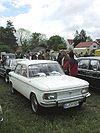
|
| NSU TTS | 4-cylinder four-stroke | 996 | 70 | 6150 | 1967-1971 |

|
| NSU 1200 / 1200C | 4-cylinder four-stroke | 1177 | 55 | 5500 | 1967-1973 |
|
|
NSU K 70 (only sold as VW K 70 ) |
4-cylinder four-stroke | 1567 | 90 | 5000 |
1969 (as VW K 70: 1970–1975) |

|
| NSU Ro 80 | Two-disc rotary engine | 2 × 498 | 115 | 5500 | 1967-1977 |

|
Timeline
| Timeline of the Auto-Union , DKW , NSU and Audi models and Volkswagen models derived from them from 1949 to 1979 | ||||||||||||||||||||||||||||||||
|---|---|---|---|---|---|---|---|---|---|---|---|---|---|---|---|---|---|---|---|---|---|---|---|---|---|---|---|---|---|---|---|---|
| Auto Union | Auto Union GmbH , independent | Auto Union GmbH , majority owned by Daimler-Benz AG | Auto Union GmbH , majority owned by Volkswagenwerk AG |
Audi NSU Auto Union AG , majority from Volkswagenwerk AG |
||||||||||||||||||||||||||||
| NSU | NSU Werke AG , independent | NSU Motorenwerke AG , independent | ||||||||||||||||||||||||||||||
| Type | Body versions | 1940s | 1950s | 1960s | 1970s | |||||||||||||||||||||||||||
| 9 | 0 | 1 | 2 | 3 | 4th | 5 | 6th | 7th | 8th | 9 | 0 | 1 | 2 | 3 | 4th | 5 | 6th | 7th | 8th | 9 | 0 | 1 | 2 | 3 | 4th | 5 | 6th | 7th | 8th | 9 | ||
| Small car | Hatchback | Audi 50 (Type 86) | ||||||||||||||||||||||||||||||
| VW Polo (Type 86) ... | ||||||||||||||||||||||||||||||||
| Notchback | NSU Prinz (type 40) | NSU Prinz 4 (Type 47) | VW Derby (Type 87) ... | |||||||||||||||||||||||||||||
| NSU Prinz 1000/1000 TT (type 67) | ||||||||||||||||||||||||||||||||
| Coupe | NSU Sport Prince (Type 41) | |||||||||||||||||||||||||||||||
| Small car / lower middle class | Notchback | NSU type 110 / NSU 1200 (type 77) | ||||||||||||||||||||||||||||||
| DKW Junior | DKW F11 / F12 | |||||||||||||||||||||||||||||||
| Cabriolet | NSU Wankel Spider (Type 56) | |||||||||||||||||||||||||||||||
| DKW F12 Roadster | ||||||||||||||||||||||||||||||||
| Middle class | Cabriolet | DKW F89 F | DKW F91 | DKW 3 = 6 (F93) | ||||||||||||||||||||||||||||
| Sedan / notchback | DKW F89 P | DKW F91 |
DKW 3 = 6 (F93 / F94) |
Auto Union 1000/1000 S. | DKW F 102 | Audi / Audi 60/75/80 / Super 90 (F103) |
Audi 80 (B1; type 80/82) |
Audi 80 (B2; type 81/85) ... |
||||||||||||||||||||||||
| Station wagon | DKW F89U | DKW F91U | DKW 3 = 6 (F94U) | Auto Union 1000 U | Audi / Audi 60/75/80 (F103) | VW Passat (B1; Type 33) ... | ||||||||||||||||||||||||||
| Hatchback / Coupe | DKW F91 | DKW 3 = 6 (F93) | Auto Union 1000/1000 S. | VW Passat (B1; Type 32) ... | ||||||||||||||||||||||||||||
| Notchback | VW K 70 (Type 86; VW Type 48) | |||||||||||||||||||||||||||||||
| upper middle class | Notchback | Audi 100 (C1) | Audi 100 (C2) ... | |||||||||||||||||||||||||||||
| Hatchback | Audi 100 Coupé S (C1) | Audi 100 (C2) ... | ||||||||||||||||||||||||||||||
| Notchback | NSU Ro 80 (type 80) | Audi 200 (C2; Type 43) ... | ||||||||||||||||||||||||||||||
| Sports car | Coupe | DKW 3 = 6 Monza | Auto Union 1000 SP | NSU TT / TTS (type 67) | ||||||||||||||||||||||||||||
| Convertible | Auto Union 1000 SP | |||||||||||||||||||||||||||||||
| Off-road vehicle | DKW Munga | |||||||||||||||||||||||||||||||
| Vans | Panel van, flatbed, bus | DKW Schnellaster (F 89 L / Type 30 / Type 3) | DKW F1000L |
sold to Daimler-Benz, continued as Mercedes-Benz N1300 |
||||||||||||||||||||||||||||
|
|
||||||||||||||||||||||||||||||||
See also

literature
- Peter Schönhaar: Contributions to the history of the development of NSU motorcycles. Volume I – V, self-published, 1983–1984.
- Peter Schneider: The NSU Story - The Chronicle of a World Brand. 1st edition, Motorbuch Verlag, Stuttgart 1997, ISBN 3-613-01853-5 .
- Peter Schneider: NSU automobiles 1905–1977. Motorbuch Verlag, Stuttgart 2008, ISBN 978-3-613-02867-8 .
- Peter Schneider: NSU in the picture - motorcycles since 1900. 1st edition, Motorbuch Verlag, Stuttgart 2000, ISBN 3-613-02063-7 .
- Peter Schneider: NSU motorcycles, 1900–1966, type compass. Motorbuch Verlag, Stuttgart 2006, ISBN 3-613-02355-5 .
- Peter Schneider: NSU 1873–1984 - From high-bike to automobile. 1st edition, Motorbuch Verlag, Stuttgart 1985, ISBN 3-613-01086-0 .
- Peter Kirchberg, Thomas Erdmann, Ralph Plagmann: The Wheel of Time - The History of AUDI AG. 3rd edition, status: 8/00, publisher: AUDI AG Ingolstadt, Verlag Delius Klasing, Bielefeld 2000, ISBN 3-7688-1011-9 .
- Ms. Herzog: NSU 1873–1923 - On the 50th anniversary of Neckarsulmer Fahrzeugwerke Aktiengesellschaft Neckarsulm. NSU GmbH, Neckarsulm 1923 (facsimile of the original from January 1987).
- Dieter Herz, Karl Reese: The NSU racing history 1904–1956. 1st edition, Motorbuch Verlag, Stuttgart 1982, ISBN 3-87943-797-1 .
- Hugo Wilson: The Lexicon of the Motorcycle. Motorbuch-Verlag, Stuttgart 2000, ISBN 3-613-01719-9 .
- Mareike Hieber, Susanne Jauch, Ralph Plagmann, Gerhard Schwinghammer: 100 years of Neckarsulm automobile manufacture. Ed .: AUDI AG - Communication, Neckarsulm, status: 09/2006.
- Arthur Westrup : Drive Prince and you are King. Stories from NSU history. Bielefeld: Delius Klasing 1995, ISBN 3-7688-0890-4 .
Web links
- German Two-Wheeler Museum - NSU Museum
- Link catalog on NSU at curlie.org (formerly DMOZ )
- nsu24.de
- Private NSU site ( Memento from April 27, 2017 in the Internet Archive )
- Early documents and newspaper articles on NSU Motorenwerke in the 20th Century press kit of the ZBW - Leibniz Information Center for Economics .
Individual evidence
- ^ Peter Schneider: The NSU Story - The Chronicle of a World Brand , Motorbuch Verlag, Stuttgart 1997
- ↑ Message from the head of the Neckarsulm city archive (Barbara Löslein) ( Memento of the original from June 10, 2011 in the Internet Archive ) Info: The archive link was inserted automatically and has not yet been checked. Please check the original and archive link according to the instructions and then remove this notice.
- ↑ nsu-griffzu.de - See under "What does the name NSU mean?"
- ^ Statement by Markus Trunzer, managing director of NSU GmbH, on the discussion page NSU Motorenwerke
- ^ The NSU company history. German Bicycle and NSU Museum, accessed on June 18, 2015 .
-
↑ Further sources of the paragraph on automobile production 1924 to 1932:
Anton Heyler: Neckarsulm in the up and down of half a century. Chronicle 1900–1950 . Welker, Neckarsulm 1955. pp. 140-149
Friedrich Dürr, Karl Wulle, Willy Dürr, Helmut Schmolz, Werner Föll: Chronicle of the City of Heilbronn. Volume III: 1922-1933 . Heilbronn City Archives, Heilbronn 1986, ISBN 978-3-928990-14-1 (Publications of the Heilbronn City Archives, 29). S. LI-LII, 184, 374, 592 - ^ Hanns-Peter von Thyssen-Bornemissza: NSU Prinz. Prince Guard . Schrader, Stuttgart 1998, ISBN 3-613-87179-3 , p. 108
- ^ Minutes of the Supervisory Board meeting on January 23, 1948
- ↑ Biography of Walter Egon Niegtsch , compiled by the NSU AG, Neckarsulm (undated)
- ^ Peter Schneider: The NSU story. Motorbuch Verlag Stuttgart 1997, p. 410 to 412.
- ↑ Peter Kirchberg: The wheel of time. Delius Klasing Bielefeld 1997, pp. 182 to 217.
- ↑ Barbara Barth: Lived solidarity decided the question of fate. Stimme.de, April 20, 2005, accessed October 2, 2016 .
- ↑ Stefan Scheytt: History written -. In: Magazin Mitbestteilung, issue 01 + 02/2010. Hans Böckler Foundation, accessed on October 2, 2016 .
- ^ Peter Schneider: The NSU story. Motorbuch Verlag, Stuttgart 1997, pp. 228-263.
- ^ Peter Schneider: The NSU story. Motorbuch Verlag, Stuttgart 1997, pp. 264-301.
- ^ Peter Schneider: The NSU story. Motorbuch Verlag, Stuttgart 1997, pp. 341–387.
- ^ Peter Schneider: The NSU story. Motorbuch Verlag, Stuttgart 2012. ISBN 978-3-613-03397-9 . Pp. 320-321.
- ^ Peter Schneider: The NSU story. Motorbuch Verlag, Stuttgart 2012. ISBN 978-3-613-03397-9 . Pp. 322-338.
- ^ Peter Schneider: The NSU story. Motorbuch Verlag, Stuttgart 2012. ISBN 978-3-613-03397-9 . Pp. 332-344.
- ^ Peter Schneider: The NSU story. Motorbuch Verlag, Stuttgart 2012. ISBN 978-3-613-03397-9 . Pp. 381-405.








